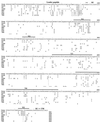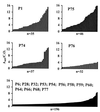Variability and immunogenicity of caprine arthritis-encephalitis virus surface glycoprotein
- PMID: 10846103
- PMCID: PMC112118
- DOI: 10.1128/jvi.74.13.6178-6185.2000
Variability and immunogenicity of caprine arthritis-encephalitis virus surface glycoprotein
Abstract
The complete surface glycoprotein (SU) nucleotide sequences of three French isolates of caprine arthritis-encephalitis virus (CAEV) were determined and compared with those of previously described isolates: three American isolates and one French isolate. Phylogenetic analyses revealed the existence of four distinct and roughly equidistant evolutionary CAEV subtypes. Four conserved and five variable domains were identified in the SU. The fine specificities of antibodies produced against these domains during natural infection were examined using a pepscan analysis. Nine immunogenic segments were delineated throughout the conserved and variable domains of SU, two of them corresponding to conserved immunodominant epitopes. Antigenic determinants which may be involved in the immunopathogenic process induced by CAEV were identified. These results also provide sensitive and specific antigen peptides for the serological detection and differentiation of CAEV and visna/maedi virus infections.
Figures




Similar articles
-
B-cell epitopes of the envelope glycoprotein of caprine arthritis-encephalitis virus and antibody response in infected goats.J Gen Virol. 2000 Dec;81(Pt 12):2929-2940. doi: 10.1099/0022-1317-81-12-2929. J Gen Virol. 2000. PMID: 11086124
-
Glycosylation of immunodominant linear epitopes in the carboxy-terminal region of the caprine arthritis-encephalitis virus surface envelope enhances vaccine-induced type-specific and cross-reactive neutralizing antibody responses.J Virol. 2004 Sep;78(17):9190-202. doi: 10.1128/JVI.78.17.9190-9202.2004. J Virol. 2004. PMID: 15308714 Free PMC article.
-
Antibody reactivity to the immunodominant epitopes of the caprine arthritis-encephalitis virus gp38 transmembrane protein associates with the development of arthritis.J Virol. 1994 Nov;68(11):7139-47. doi: 10.1128/JVI.68.11.7139-7147.1994. J Virol. 1994. PMID: 7933096 Free PMC article.
-
Demonstration of coinfection with and recombination by caprine arthritis-encephalitis virus and maedi-visna virus in naturally infected goats.J Virol. 2007 May;81(10):4948-55. doi: 10.1128/JVI.00126-07. Epub 2007 Mar 7. J Virol. 2007. PMID: 17344293 Free PMC article.
-
Rapid evolution of two discrete regions of the caprine arthritis-encephalitis virus envelope surface glycoprotein during persistent infection.Virus Res. 2002 Mar 20;84(1-2):17-25. doi: 10.1016/s0168-1702(01)00421-x. Virus Res. 2002. PMID: 11900835
Cited by
-
The Vif protein of caprine arthritis encephalitis virus inhibits interferon production.Arch Virol. 2020 Jul;165(7):1557-1567. doi: 10.1007/s00705-020-04637-z. Epub 2020 Apr 30. Arch Virol. 2020. PMID: 32356187
-
Conservation of human immunodeficiency virus type 1 gp120 inner-domain sequences in lentivirus and type A and B retrovirus envelope surface glycoproteins.J Virol. 2001 Feb;75(4):2014-8. doi: 10.1128/JVI.75.4.2014-2018.2001. J Virol. 2001. PMID: 11160703 Free PMC article.
-
Analysis of the antibody response to an immunodominant epitope of the envelope glycoprotein of a lentivirus and its diagnostic potential.J Clin Microbiol. 2006 Mar;44(3):981-91. doi: 10.1128/JCM.44.3.981-991.2006. J Clin Microbiol. 2006. PMID: 16517887 Free PMC article.
-
Small ruminant lentiviruses: genetic variability, tropism and diagnosis.Viruses. 2013 Apr 23;5(4):1175-207. doi: 10.3390/v5041175. Viruses. 2013. PMID: 23611847 Free PMC article. Review.
-
Domain Organization of Lentiviral and Betaretroviral Surface Envelope Glycoproteins Modeled with AlphaFold.J Virol. 2022 Jan 26;96(2):e0134821. doi: 10.1128/JVI.01348-21. Epub 2021 Oct 27. J Virol. 2022. PMID: 34705555 Free PMC article.
References
-
- Banks K L, Adams D S, McGuire T C, Carlson J. Experimental infection of sheep by caprine arthritis-encephalitis virus and goats by progressive pneumonia virus. Am J Vet Res. 1983;44:2307–2311. - PubMed
-
- Bertoni G, Zahno M L, Zanoni R, Vogt H R, Peterhans E, Ruff G, Cheevers W P, Sonigo P, Pancino G. Antibody reactivity to the immunodominant epitopes of the caprine arthritis-encephalitis virus gp38 transmembrane protein associates with the development of arthritis. J Virol. 1994;68:7139–7147. - PMC - PubMed
-
- Carpino L A, Han G H. The 9-fluoronylmethoxycarbonyl function, a new base sensitive amino protecting group. J Org Chem. 1970;37:5748–5749.
-
- Chebloune Y, Karr B, Sheffer D, Leung K, Narayan O. Variations in lentiviral gene expression in monocyte-derived macrophages from naturally infected sheep. J Gen Virol. 1996;77:2037–2051. - PubMed
Publication types
MeSH terms
Substances
Associated data
- Actions
- Actions
LinkOut - more resources
Full Text Sources

